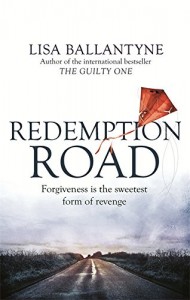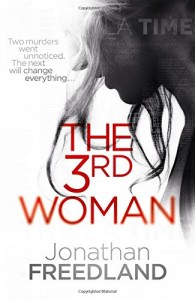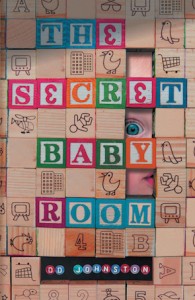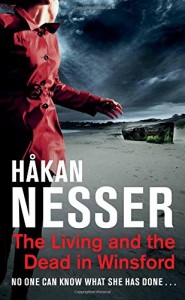 Redemption Road by Lisa Ballantyne published by Piatkus
Redemption Road by Lisa Ballantyne published by Piatkus
The 3rd Woman by Jonathan Freedland published by HarperCollins UK/Harper US
The Secret Baby Room by D.D.Johnston published by Barbican
The Living and the Dead of Winsford by Håkan Nesser published by Mantle UK
Into the Fire by Manda Scott published by Bantam
Until I read Redemption Road, no novel had given me nightmares for a very long time. As a child, I was distressed by a story in which a character was gagged with a bar of soap, waking the following morning with the taste of soap in my own mouth. Half-way through Lisa  Ballantyne’s second novel, I was almost equally disturbed.
Ballantyne’s second novel, I was almost equally disturbed.
This is a timeslip story, dealing with the abduction of seven-year-old Moll in 1985 and the distress of adult Margaret Holloway in 2013. The adult has no memory of her childhood trauma, although its effects have lingered, until she is rescued by a stranger when her car bursts into flames after a collision. Then she starts to dig into her past to make sense of everything that has puzzled her.
Although the 2013 hero’s identity isn’t disclosed, Ballantyne makes no mystery of the 1985 abductor’s: he is George, Moll’s natural father, who wasn’t allowed to marry her mother because of the terrible reputation of his violent criminal family. Illiterate, beaten for his left-handedness by the nuns who were supposed to be educating him, smashed up by his father, bullied by his siblings, he grew up yearning for proper family life. Hence his abduction of his daughter, whose stepfather moved her and her mother to Scotland.
The account of the relationship that develops between George and Moll as he evades his various pursuers is disturbingly convincing. I could  have done without an unnecessary subplot about a violent religion-obsessed journalist who loves his pregnant cow a great deal more than his wife, and the sentimental twist at the end lessened the dramatic impact, but the core of the novel works well. And it gave me a nightmare.
have done without an unnecessary subplot about a violent religion-obsessed journalist who loves his pregnant cow a great deal more than his wife, and the sentimental twist at the end lessened the dramatic impact, but the core of the novel works well. And it gave me a nightmare.
Three of this month’s other novels are written by men in the voice of women. Jonathan Freedland, a serious journalist who has published bestsellers under the name Sam Bourne, explores a possible future in which China has taken over from the United States as the world’s superpower and planted garrisons on American soil. I was reminded of Daphne du Maurier’s entertaining Rule Britannia(1972), in which she imagined the UK taken over by America after the failure of the European Union. At this time of uncertainty over the Euro and the possible exits of some of the member states, it seems suddenly topical again. du Maurier’s fictional alliance, charmingly called ‘USUK’, was smashed by the magnificent elderly actress known as Mad.
Freedland’s Madison Webb is a journalist, prickly and difficult but effective in her attempts to expose corruption and official dishonesty. Like so many of the genre’s sleuths, she has an unhappy private life. In her case this consists of: failed relationships; a dead father; a mother with dementia; a bossy and dislikeable elder sister; and a younger one who makes her feel guilty. When the youngest of the three is murdered and the killer seems to come from the crowd of over-privileged Chinese princelings so resented by their American neighbours, Maddy faces many interested parties determined to stop her finding the truth. The 3rd Woman offers a powerful mixture of well-researched political surmise and crowd-pleasing pace.
 D. D. Johnston teaches creative writing and is a lot less interested in pace. His novel deals with Claire Wilson, recently moved in to a new, jerry-built house in Manchester with her husband, Dan. She had a miscarriage nine months ago and wants to get pregnant again. He’s not so sure and when she starts seeing babies where no babies could possibly be, he’s convinced she’s losing it, as are the local police to whom she reports her suspicions. Claire and Dan have a depressingly incompetent relationship, and it is hard to see why she would stay with such a man. But credibility doesn’t seem to be one of D. D. Johnston’s interests. The police officers and several minor characters seem to have been created more to make points than to convince as human beings. One of the neighbours is Morgana, a middle-aged hippy with a longing to heal the earth, who has called her children Unity and Mooncloud. On the other side of Claire’s house lives a fake-tanned slapper with a secret and a taste for huge glasses of wine. A graffiti artist working in an old-people’s home on the minimum wage is surprisingly articulate when he’s not talking in the local dialect, which comes and goes without much reason. There is serious intent here, and some important social issues are raised, but the tone shifts uncomfortably between gloom and comedy, and the novel lacks spark.
D. D. Johnston teaches creative writing and is a lot less interested in pace. His novel deals with Claire Wilson, recently moved in to a new, jerry-built house in Manchester with her husband, Dan. She had a miscarriage nine months ago and wants to get pregnant again. He’s not so sure and when she starts seeing babies where no babies could possibly be, he’s convinced she’s losing it, as are the local police to whom she reports her suspicions. Claire and Dan have a depressingly incompetent relationship, and it is hard to see why she would stay with such a man. But credibility doesn’t seem to be one of D. D. Johnston’s interests. The police officers and several minor characters seem to have been created more to make points than to convince as human beings. One of the neighbours is Morgana, a middle-aged hippy with a longing to heal the earth, who has called her children Unity and Mooncloud. On the other side of Claire’s house lives a fake-tanned slapper with a secret and a taste for huge glasses of wine. A graffiti artist working in an old-people’s home on the minimum wage is surprisingly articulate when he’s not talking in the local dialect, which comes and goes without much reason. There is serious intent here, and some important social issues are raised, but the tone shifts uncomfortably between gloom and comedy, and the novel lacks spark.
Håken Nesser’s main character enjoys huge glasses of wine and has a difficult marriage, too, but in every other respect could not be more different. Maria is a Swedish television newsreader and presenter, married to academic Martin Holinek. For reasons unspecified at the start of  The Living and the Dead in Winsford, she has rented a damp and depressing little house on the edge of Exmoor and is making a life for herself there with her dog, Castor. While she battles with loneliness, damp and some notebooks and typescripts belonging to her absent husband, she gradually tells the reader more about their life together. The secrets she reveals become increasingly dramatic as she learns to allow herself some pleasure in her new life and the people she finds in it.
The Living and the Dead in Winsford, she has rented a damp and depressing little house on the edge of Exmoor and is making a life for herself there with her dog, Castor. While she battles with loneliness, damp and some notebooks and typescripts belonging to her absent husband, she gradually tells the reader more about their life together. The secrets she reveals become increasingly dramatic as she learns to allow herself some pleasure in her new life and the people she finds in it.
Maria is an interesting and mainly convincing woman. Her struggles with her domestic travails in England, her difficult memories, her husband’s written revelations, and her ideas of justice give the novel real intensity. The characters she encounters in and around Winsford have much to recommend them, and her relationship with Castor is fun. I have one major quarrel with the plot. Asking myself ‘how could such an intelligent woman believe…?’, I expected an explanatory twist that never came. But in every other respect I admired and enjoyed the novel. Nesser’s depiction of the moor itself, in all its bleak beauty, terrible weather, roaming herds of wild ponies and scary hazards, offers particular pleasure.
 Manda Scott also explores old secrets and ideas of justice in Into the Fire, which is set in Orléans and moves between the present day and the early fifteenth century. Today Capitaine Inès Picaut has to investigate a series of arson attacks, the latest of which has killed a man; while the fifteenth-century sections follow the war between the French and English, which led to the death by burning of La Pucelle d’Orléans, known to the English as Joan of Arc.
Manda Scott also explores old secrets and ideas of justice in Into the Fire, which is set in Orléans and moves between the present day and the early fifteenth century. Today Capitaine Inès Picaut has to investigate a series of arson attacks, the latest of which has killed a man; while the fifteenth-century sections follow the war between the French and English, which led to the death by burning of La Pucelle d’Orléans, known to the English as Joan of Arc.
The two sections are linked in more ways than one. Picaut’s late father was passionately interested in the identity of the woman who died at the stake and did not believe she could have been the simple virgin peasant of legend, and Picaut’s estranged and deeply right-wing husband, Luc, and his rich family are determined to use that same legend to whip up anti-foreigner sentiment in a forthcoming mayoral election.
They offer Picaut a deal: if she will pose for photographs in a couture dress with Luc at a political rally just once, they’ll set her free from the marriage she detests. The price seems worth paying, and they don’t warn her that they’ll set up a backdrop of film of the arsonist’s flames and embarrassingly publicize her recent successes at work as they try to make everyone believe she is the new Joan of Arc, fighting wicked foreigners for the honour of France.
Both sections are beautifully written, well researched, and gripping. The characters are entirely credible, whether modern or historical, and the novel as a whole is like a great medieval feast, with a huge array of colourful and highly flavoured treats spread out for our delectation. I gorged and loved it all.
